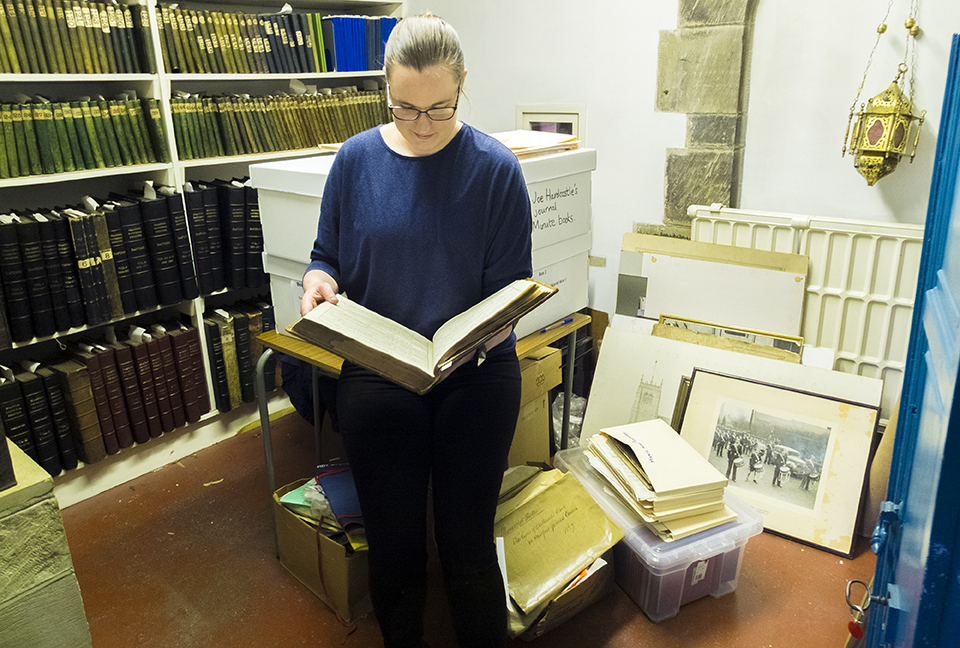Have you ever wondered what items of interest are held in Bradford Cathedral? Perhaps you’ve wanted to look up old records as part of a research project? Maybe you’ve wondered how such historical items can be preserved for future use?
Well, so did those at the Cathedral, and they invited the West Yorkshire Archive Service to uncover the secrets of their stores – which contain everything from record ledgers to old photographs – to see what treasures exist and how they can be preserved for future generations to enjoy.
Fiona Marshall, a Bradford-based archivist with the service, came along to the cathedral in mid-April to investigate just what can be found within the building. Her overall role is to preserve and provide access to the documentary heritage of the Bradford area. This includes items of interest like parish records for the churches that make up the former Bradford Diocese, including Bradford Cathedral. Fiona came in one Friday to survey the records, with a view of bringing them into the archive where they can be made publicly accessible.
The West Yorkshire Archive Service helps the public access the records, answers any questions, and make sure no harm comes to the items stored. Fiona also goes on site to places of interest to find out what is held.
Fiona started her investigation at Bradford Cathedral with the parish registers. “They are a massive run of records dating from the 1590s through to 2014. They are often one of the few demographic sources that pre-date civil registration, and they can be really valuable sources for people looking at the history of an area.
“For example, I’ve come across a burial register from 1832 which records the causes of death in the margins, including when people had died in the outbreak of cholera. Some of these records have been digitised in the past and made available on Ancestry.co.uk, but we want to make sure that the original records can be preserved.”
Archiving is an important act of preservation abd those at the West Yorkshire Archive Service works to keep records in-tact. “We store things in line with international standards, in terms of humidity and temperature. We often preserve the only copy or version of records for business use, or for people looking to learn more about themselves and their area. It’s very important that have people have access to these in the future.”
Looking forward, some of the most heavily used records, such as the parish records, will be digitised with digital partners, like Ancestry. WYAS has recently relaunched Bradford Tithe maps online at http://wytithemaps.org.uk/. The site provides access to 16 Tithe maps and apportionments data for the Bradford district. Tithe maps are often the first large scale map of an area, and with the surveys that accompany them, can help people see what Bradford looked like in the 1800s, who owned different plots of land, and how they were being used.
The cathedral records can be also very useful for genealogists. “Family historians make up a massive user base for us. The parish records are an important resource for them, but they can also be used by academics looking at the history of the area. There’s the medical history for people who are tracking causes of death, such as the cholera outbreak. There are also plans for architectural historians; really it’s anything and everything!
“You can help plan the future by looking at the past.”
The archival process is fascinating and includes investigating and cataloguing the items found. Fiona started by looking back at previous lists created in the 1970s and those created by staff at the cathedral, checking that they match the items in the store, and seeing what’s new; “I’m going through to check what is there, solve any confusion, and check that everything is matching up. I’ll be looking at records that aren’t on the list, and where more recent records are located.”
There’s also a very important preservation element. “If you think about the places people keep records themselves: maybe in their attic or their basement, or a cupboard. Places where they’re at risk of damage or cold. Obviously the older the building is, the more chance there is for that to occur. That’s why it’s really important for us to do this work.”
Before Fiona got back to the investigation, we asked her what she was most looking forward to uncovering. “I’m looking particularly for early township papers that pre-date records of local authorities. I’m expecting to find some from the 1600s like overseers records or churchwarden’s accounts, which are among the few places where everyday people will have been recorded; I’m really hoping to find something like that!”
You can find out more about the West Yorkshire Archive Service at wyjs.org.uk/archive-service and follow them on Twitter @wyorksarchives

